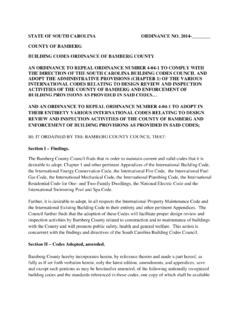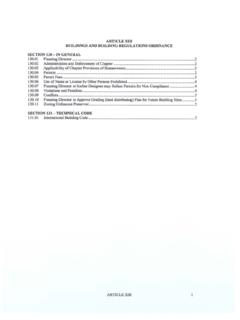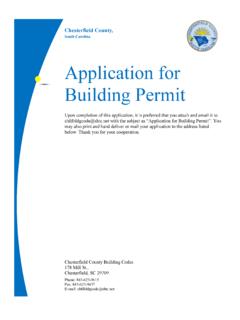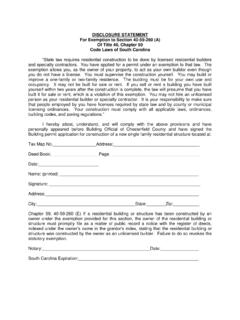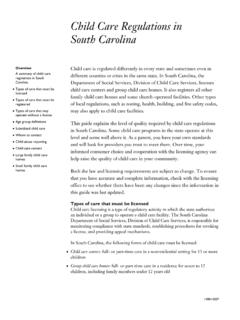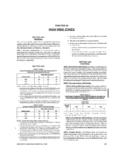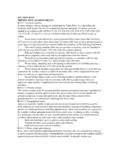Transcription of Residential Construction Standards
1 SouthCarolinaResidentialConstructionStan dardsThe Residential Builders Commission of the south carolina Department of Labor, Licensing and Regulation adopted the Residential Standards as the Guidelines by which all investigations shall be conducted, as approved July 26, 1995 and revised October 29, by the Commission on February 18, of ContentsCHAPTER I - APPLICABLE TIME LIMITS AND building II - INTRODUCTION TO III - CARPENTRY Standards - ROUGH ..7 CHAPTER IV - CARPENTRY Standards - FINISH ..11 CHAPTER V - CAULKING & WEATHER-STRIPPING VI - DRYWALL AND PLASTER VII - ELECTRICAL VIII - FIREPLACE IX - FLOORING FINISH X - CARPETING Standards ..32 CHAPTER XI - CERAMIC AND QUARRY XII - RESILIENT FLOORING XIII - WOOD FLOORING Standards ..41 CHAPTER XIV - GARAGE DOOR Standards ..44 CHPATER XV - GRADING, GROUND REMOVAL, GRAVEL, AND FILL FILL XVI - HARDWARE AND LIGHTING FIXTURE Standards .
2 52 CHAPTER XVII - HEATING & SHEET METAL XVIII - INSULATION XIX - MASONRY & CONCRETE XX - MOISTURE XXI - PAINTING, STAINING AND WALLPAPERING STANDARDS74 CHAPTER XXII - PLUMBING Standards ..79 CHAPTER XXIII - ROOFING XXIV - SIDING XXV - WINDOW XXVI - SKYLIGHT XXVII - SITE DRAINAGE AND EROSION ..98 CHAPTER XXVIII - STUCCO ..99 CHAPTER XXVIX - MANUFACTURER INSTALLATION ..1004 CHAPTER I APPLICABLE TIME LIMITSThe Commission, under normal conditions, will inspect for code violations during the time limits shown below. Contractor responsibility does not extend to items, which have been subject to owner neglect, modification, or abnormal in appliances, fixtures and heating/air conditioning equipment, properlyinstalled by the contractor, shall be limited to the manufacturer s in this section creates a warranty or limits a following classifications shall be open to inspection for code violations for the first twenty-four , fill and other site and concrete* and wood products* and : paint, stain, wallpaper, carpet, tiles, flooring, and and *11.
3 And and weatherstripping14. HardwareThe following classifications shall be open to inspection for code violations for the first forty-eight months:1. Heating and air conditioning2. Plumbing3. ElectricalMajor structural damage, including structural damage to systems noted above by anasterisk*, and building which are unsafe, unsanitary, do not provide adequate egress, constitute a fire hazard, or are otherwise dangerous to human life shall be inspected for code violations during the first eight years by the Commission on June 8, July 1, 20055 APPLICABLE building CODESB uilding codes change from time to time. For the purpose of these Standards , the building codes governing the structural, mechanical, plumbing, electrical, gas and energy requirements for new Construction , that was adopted and in effect at the time the house was constructed, must be used to determine compliance.
4 Inspection of specificcomponents or systems by registered inspectors of the governmental authority having jurisdiction will provide evidence of presumed building codes were not adopted and in effect at the time the house was constructed, the following will apply to all structural, mechanical, plumbing, electrical, gas and energy systems:1. If the house was constructed prior to July 1, 2002;A. The 1995 edition of the CABO One and Two Family Dwelling and Model Energy Codes; or,B. The 1997 edition of the Standard Mechanical, Plumbing and Gas Codes, the 1996 edition of the National Electrical code and the CABO Model Energy If the house was constructed after July 1, 2002;A. The edition of the International Residential code adopted and in effect at the time Construction was by the Commission on June 8, July 1, 20056 CHAPTER IIINTRODUCTION TO Construction STANDARDSThe Construction Standards are intended to specify the minimum performancestandards for Construction of homes and to set forth the basis for determining the validity of all home buyer complaints related to defective materials and workmanship during the initial one- year warranty the most frequent defects of concern to the industry have been addressed in the Construction Standards set forth in the following pages.
5 It is not possible to discuss every conceivable situation that can occur in building . Because of the limitless combinations that can be incorporated into a home, infinite conditions can occur. This manual describes the most common and repetitive situations. Likewise, the validity of any homeowner scomplaint for defects for which a standard has not yet been addressed herein shall be determined on the basis of good industry practice, which assures quality of materials and workmanship, and any conciliation or arbitration of such complaints shall be following Construction Standards are expressed in terms of performance Standards . Noncompliance with the performance standard calls for corrective action by the format is designed for easy comprehension by both layman and builder as Defect or Problem a brief statement in simple terms of the problems to be Standard Performance Standards relating to a specific Repair Responsibility statement of the corrective action required of the builder to repair the deficiency or any other damage resulting from making the required repair.
6 The method of correction to meet the industry standard is at the builder s discretion. Alternatives for making acceptable repairs exist in most are many items that are homeowner maintenance responsibilities. To assure themselves of long, comfortable use of their home and protection of their investment, homeowners should learn about and act on those maintenance III CARPENTRY Standards - ROUGH (Rough Carpentry, Lumber & Truss)Framing or rough carpentry provides the skeletal structure which includes fabrication of wood portions of the floor systems, exterior walls, interior partitions and roof which are built on and supported by the exterior wall framing is designed to support the vertical load from the floors and roof and to resist lateral loads resulting from winds.
7 Interior partitions may or may not be load bearing. The roof is designed to support its own weight plus that of anticipated loads from snow, ice and wind. The framing is quality controlled by the building code and subject to building inspection when the entire framed structure can be framing can be fabricated on or off a job site, or a combination of both. Even when most of the framing is done on site, there has been a trend to use premanufactured components, such as roof or floor trusses, in lieu of the more conventional joist and rafter Construction . As a natural product, wood will respond to humidity and temperature conditions and can cause shrinking, twisting or warping of the framing material. Some of these conditions can be controlled or minimized; others are due to the nature of wood single family Construction , lumber type and grade, span, spacing and load bearing capacities are tightly controlled by code , while the carpentry foreman uses his ownjudgment in determining the exact layout.
8 Hence, the accumulation of tolerances of several inches in overall dimension is not Defect or ProblemFloors StandardFloor squeaks are common to new Construction and a squeak-proof floor cannot Repair ResponsibilityBuilder should try to minimize the floor squeaks and must correct if caused by a Construction defect. It should be noted that a second floor repair would be surface nailing in carpeted areas and impossible in vinyl or ceramic Defect or ProblemUneven or unlevel floors8 Performance StandardFloors shall not be more than out of plane or level in wood, vinyl and ceramic areas or out of plane in carpeted areas within any 32 measurement whenmeasured parallel to the Repair ResponsibilityBuilder to repair to meet performance Defect or ProblemCrowned floor StandardFloors shall not be more than out of plane or level in wood.
9 Vinyl and ceramic areas or out of plane in carpeted areas within any 32 measurement whenmeasured parallel to the Repair ResponsibilityBuilder to repair to meet performance standard Defect or ProblemSeams or ridges appear in the resilient flooring due to subfloor StandardIn the natural settling and shrinkage process, some mismatch of the subfloor may exhibit and mirror itself as ridges or depressions showing on the surface can be minimized by the customer in his selection of an embossed pattern in a darker color. In particular, lighter solid colors and/or smooth vinyl surfaces mirror any minor variations of the subsurfaces to which they are applied and emphasize this ridging. If the ridge or depression effect exceeds 1/8 and cannot be corrected from below, the resilient floor must be corrected.
10 The ridge measurements should be made by measuring the gap created when a 6 straight edge is placed tightly 3 on each side of the defect and the gap measured between the floor and the straight edge at the other end. Builder Repair ResponsibilityIf ridges exceeds standard, builder to remove the sheet goods in the minimum area where the joint will not be readily visible when repaired, renail the subflooring, sand smooth and/or fill gap and replace the sheet goods. Owner should note that there may be a mismatch in materials due to time or dye lot variations. If the material is unavailable due to discontinuation, unless the owner will accept a repair 9with as closely matching materials as is currently available or correction by some other means, builder should credit the owner 1 times the cost to repair if the material were available.
